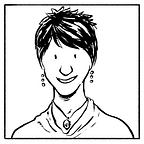Designing Powerful Public Conversations
There’s an alchemy when people get together face-to-face to ponder a tough issue and what to do about it. Good conversations are game changers. They help us connect with the topic, see issues in a new light, and shift how we relate to people different from us. All that impacts our willingness to work together to solve wicked problems.
Democracy is not a spectator sport and if we want our world to be a better place then a diverse array of people need to participate in community problem-solving. Creatively designed public conversation events invite the kind of participation through which the wider public can respectfully explore a thorny topic together. Public radio stations, in our role as community conveners and storytellers, are uniquely positioned to make these events happen.
But how? Here are ten strategies I developed while designing a series of public conversations called Hunger in the Farm-to-Fork Capital as part of Capital Public Radio’s multiplatform documentary project Hidden Hunger. My ideas are informed by The World Café, literary salons, and my own experience throwing big parties.
These strategies aren’t unique to pubradio events. They’ll work for anyone interested in sparking conversations through storytelling activities. Scroll to the end for a handy infographic. And check out this video to see what these events were like.
Invite Unlikely Allies
Great parties have a diverse mix of people and a host who knows how to connect them. The collision of different points of view provokes new understandings and creates relationships among people who wouldn’t otherwise meet. Deliberately invite a wide cross-section of residents to attend the public event.
Create the Space
The physical space is the container for the participant’s experience. Create an environment that is beautiful, inviting, and living-room-like to establish that your event is more than a typical civic meetup. For example, seat guests at round tables featuring colorful tablecloths, fresh flowers, and appetizers.
People do their best thinking when they feel comfortable and engaged. They listen and stay open to new ideas when the atmosphere is respectful. Find ways to create and communicate a warm, open, and generous atmosphere throughout every aspect of the event. One idea: provide table hosts that welcome and introduce participants as they sit down.
Set The Tone
People do their best thinking when they feel comfortable and engaged. They listen and stay open to new ideas when the atmosphere is respectful. Find ways to create and communicate a warm, open, and generous atmosphere throughout every aspect of the event. One idea: provide table hosts that welcome and introduce participants as they sit down.
Give the Context
Begin the event with a warm welcome. Clearly convey the reason you are bringing people together and what you hope to achieve. Establish a spirit of inquiry and the goal of sharing experiences, listening to one another, and making meaning together about a social issue. Review etiquette and give participants a road map for what’s to come.
Tell Me A Story
Communicate with stories, not statistics. Personal stories build understanding and empathy. Their intimacy and immediacy connect us with our own values and circumstances. Play a few audio clips and invite selected community leaders to respond by sharing personal and professional reflections.
Connect The Dots
Give participants time to talk in small groups about the stories and speakers. Provide table hosts with questions that encourage participants to share personal reflections and surface connections between their lives and the experiences of storytellers.
Mix It Up
Have you ever been seated at a table and felt stuck there? Or just wanted the chance to talk to more people at a gathering? Make the experience playful and energizing by having participants switch tables during the event. This allows them to meet new people and cross-pollinate ideas between conversations.
Share Collective Insights
Bring the entire group together towards the end of the event to reflect on the experience they’ve just had. Elicit common themes and discoveries to identify patterns, share new knowledge, and build a shared understanding of the kind of community that they want to live in.
Provide A Path Forward
Powerful conversations fire people up. Create ways for participants to continue the conversation, learn more, and get involved. Engage community partners in generating concrete and timely action steps to share with participants at the end of the event.
Assess and Share Results
Use graphic recorders, event surveys, exit interviews or other tools to gauge the impact of the experience on participants. Share data so community partners can advance their goals. Dynamic conversation events are a team effort — celebrate your collective success with a party to acknowledge everyone’s contributions.
Here is a handy cheat sheet of the above steps.
Photos by Steve Frisch, Fischphoto.com
Graphics by Tina Chen, tinachendesign.com
